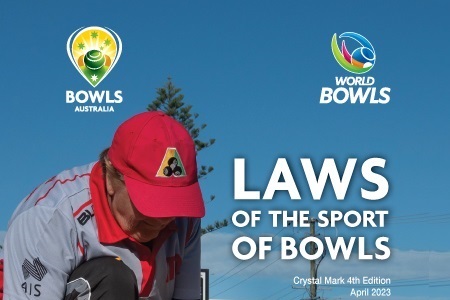
Stricter penalties for stopping bowls
UPDATE: Law 37.1.3 and Law 37.1.5.3 have been rescinded by the World Bowls Law Advisory Group. For full details of this change, see the Bowls Australia post World Bowls Memo – changes to Laws of the Sport.
The following advice is no longer relevant
The following information was copied (with slight editing) from a Bowls Australia post – Laws of the Sport of Lawn Bowls – Crystal Mark 4th Edition – by John Roberts, Chair of the National Officiating Advisory Group (NOAG). The full article contains other information about changes to the Laws in the 4th edition.
Stopping bowls
In the Crystal Mark 4th Edition (CM4) [of the Laws of the Sport of Lawn Bowls], two new Laws were approved and included within Law 37.1 “Bowl Displacement by another player”, to alleviate the situation of a player stopping one of their own team’s bowls from disturbing the head and gaining an advantage either by lifting a bowl at rest or stopping their bowl in its original course – that is cheating.
These [new laws] are:
- Law 37.1.3, if a player deliberately stops or displaces one of their own team’s bowls in its original course; or
- Law 37.1.5.3, if a player deliberately lifted a bowl at rest to allow their own bowl to continue on its original course.
The World Bowls Laws Committee (WBLC) felt that a clear deliberate intent by a player to interfere with their own bowls in this way should warrant a more severe penalty which would be the forfeiture of the game. Both Laws state that the “defaulting team will forfeit the game to their opponent”. Interestingly, in Pennant, this would mean the side would forfeit their game to their opponent – a tough call.
The NOAG has since suggested to the WBLC that the penalty is too severe, while recognising that the action is cheating, with the NOAG suggesting a similar penalty along the lines of Instantaneous Penalties such as 8 shots as an example in pennant. Ultimately, this was rejected by the WBLC.
The WBLC has identified that these new Laws were not introduced to ‘punish’ players that stop a bowl from entering the ditch that hasn’t disturbed the head. The WBLC understands this occurs on a regular basis, but it is a timely reminder and a key message from the World Bowls Laws Committee that no bowl belonging to the players on the rink of play should be lifted, stopped, or displaced.
Other Laws are available to deal with situations where bowls displace other bowls and the jack, and these should still be applied accordingly.
When can a bowl be stopped legally?
The markers duties make it clear that a marker must stop a bowl from a neighbouring rink if the bowl could move a jack or bowl at rest. (Law 42.2.11).
Bowl displacement by a bowl from a neighbouring rink Law 37.6.1.2 allows any player on that rink to stop a bowl from a neighbouring rink if a bowl at rest is in danger of being moved by a bowl from a neighbouring rink.
Law 37.6.1.1 also allows a player to lift a bowl at rest to allow the other bowl to pass and then replace it. NOAG prefers the action of stopping a bowl from a neighbouring rink in preference to lifting, but both are permissible under the Laws of the Sport.
WLBC’s advice now to all bowlers is that if a bowl is legally on course on your rink, allow it to take its full course and do not stop it. Bad habits of stopping bowls from going into ditches was never allowed by the Laws of the sport but is a habit that many bowlers have adopted. This is often done to stop the need to clean bowls from wet sand, more convenient to recover a bowl and or to avoid a non-toucher from displacing a jack or bowls already in the ditch.
Remember Law 60!
Remember also that Law 60, the last one in the Law book, clearly states that no Controlling body or individual has the right or power to contract out any of the Laws of the Sport of Bowls. So, whether it be local, state, national or international competition, we cannot ignore any of the Laws of the Sport including the new Laws in CM4.
